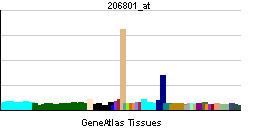Species Human Entrez 4879 | Human Mouse Ensembl ENSG00000120937 | |
 | ||
Aliases NPPB, BNP, natriuretic peptide B External IDs OMIM: 600295 HomoloGene: 81698 GeneCards: NPPB | ||
Brain natriuretic peptide or B-type natriuretic peptide (BNP) (also ventricular natriuretic peptide or natriuretic peptide B) is a 32-amino acid polypeptide secreted by the ventricles of the heart in response to excessive stretching of heart muscle cells (cardiomyocytes). The release of BNP is modulated by calcium ions. BNP is named as such because it was originally identified in extracts of porcine brain, although in humans it is produced mainly in the cardiac ventricles.
Contents
BNP is secreted attached to a 76–amino acid N-terminal fragment in the prohormone called NT-proBNP (BNPT), which is biologically inactive. Once released, BNP binds to and activates the atrial natriuretic factor receptors NPRA, and to a lesser extent NPRB, in a fashion similar to atrial natriuretic peptide (ANP) but with 10-fold lower affinity. The biological half-life of BNP, however, is twice as long as that of ANP, and that of NT-proBNP is even longer, making these peptides better targets than ANP for diagnostic blood testing.
The physiologic actions of BNP are similar to those of ANP and include decrease in systemic vascular resistance and central venous pressure as well as an increase in natriuresis. The net effect of these peptides is a decrease in blood pressure due to the decrease in systemic vascular resistance and, thus, afterload. Additionally, the actions of both BNP and ANP result in a decrease in cardiac output due to an overall decrease in central venous pressure and preload as a result of the reduction in blood volume that follows natriuresis and diuresis.
Biosynthesis
BNP is synthesized as a 134-amino acid preprohormone (preproBNP), encoded by the human gene NPPB. Removal of the 25-residue N-terminal signal peptide generates the prohormone, proBNP, which is stored intracellularly as an O-linked glycoprotein; proBNP is subsequently cleaved between arginine-102 and serine-103 by a specific convertase (probably furin or corin) into NT-proBNP and the biologically active 32-amino acid polypeptide BNP-32, which are secreted into the blood in equimolar amounts. Cleavage at other sites produces shorter BNP peptides with unknown biological activity. Processing of proBNP may be regulated by O-glycosylation of residues near the cleavage sites.
Measurement
BNP and NT-proBNP are measured by immunoassay.
Interpretation of BNP
A cutoff in BNP concentration of 100 pg/ml has, for cardiac events, a sensitivity of approximately 100%, a negative predictive value of approximately 100%, a specificity of 90%, and a positive predictive value of 78% according to data from the United Kingdom.
BNP is cleared by binding to natriuretic peptide receptors (NPRs) and neutral endopeptidase (NEP). Less than 5% of BNP is cleared renally. NT-proBNP is the inactive molecule resulting from cleavage of the prohormone Pro-BNP and is reliant solely on the kidney for excretion. The achilles heel of the NT-proBNP molecule is the overlap in kidney disease in the heart failure patient population.
Low BNP was found to be a predictor of survival to age 90 in men.
Some laboratories report in units ng per Litre (ng/L), which is equivalent to pg/mL
There is a diagnostic 'gray area', often defined as between 100 and 500 pg/mL, for which the test is considered inconclusive, but, in general, levels above 500 pg/ml are considered to be positive. This so-called gray zone has been addressed in several studies, and using clinical history or other available simple tools can help make the diagnosis.
BNP may be a reliable predictor of cardiovascular mortality in diabetics.
BNP was found to have an important role in prognostication of heart surgery patients and in the emergency department. Bhalla et al. showed that combining BNP with other tools like ICG can improve early diagnosis of heart failure and advance prevention strategies. Utility of BNP has also been explored in various settings like preeclampsia, ICU and shock and ESRD.
The effect or race and gender on value of BNP and its utility in that context has been studied extensively.
The BNP test is used as an aid in the diagnosis and assessment of severity of heart failure. A recent meta-analysis concerning effects of BNP testing on clinical outcomes of patients presenting to the emergency department with acute dyspnea revealed that BNP testing led to a decrease in admission rates and decrease in mean length of stay, although neither was statistically significant. Effects on all cause hospital mortality was inconclusive. The BNP test is also used for the risk stratification of patients with acute coronary syndromes.
When interpreting an elevated BNP level, it is useful to remember that values may be elevated due to factors other than heart failure. Lower levels are often seen in obese patients. Higher levels are seen in those with renal disease, in the absence of heart failure.
Therapeutic application
Recombinant BNP, nesiritide, is used to treat decompensated heart failure. However, a recent clinical trial failed to show a benefit of nesiritide in patients with acute decompensated heart failure, and the authors could not recommend its use.
